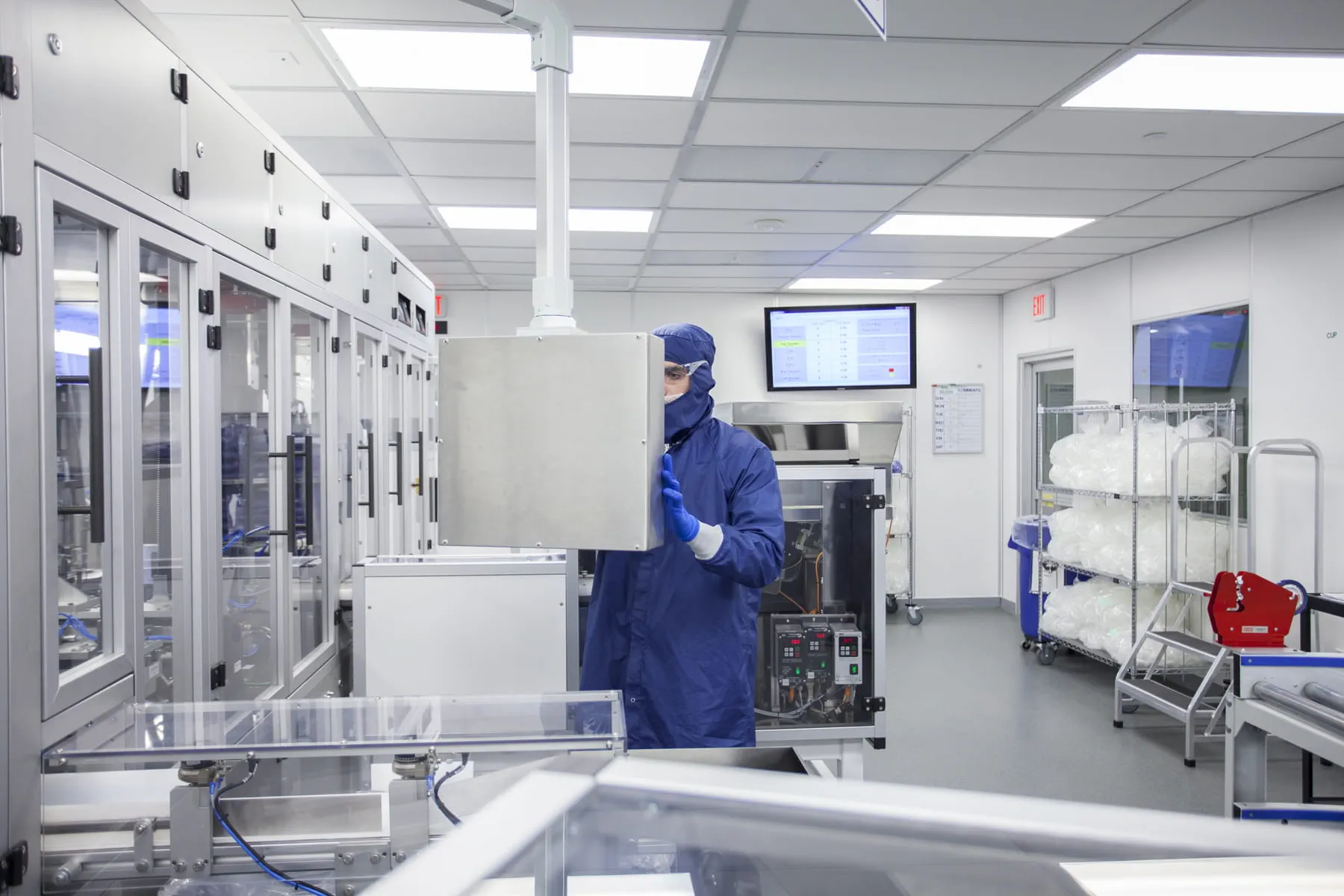Most frequently asked questions on the revised EU GMP Annex 1: Volume 6
In August 2022 the European Union revised its guidelines for sterile medicinal products for human and veterinary use. These guidelines came into effect on August 25, 2023. West has compiled the most frequently asked questions about Annex 1 and how it affects sterile drug manufacturers, which will be published across a multi-part series.

1. What types of contamination can be present in a pharma manufacturing facility, and what risks do they pose?
Contamination in a pharmaceutical manufacturing facility can be broadly categorized into four main types: microbial, particulate, chemical, and cross-contamination. Each poses significant risks to both patient safety and the manufacturer’s operational and reputational integrity.
Microbial Contamination:
This includes bacteria, fungi, and viruses that can infiltrate sterile or non-sterile products. Microbial contamination is particularly critical in aseptic processing, where even a single microorganism can compromise product sterility. For patients, this can lead to serious infections, particularly in immunocompromised individuals. For manufacturers, such contamination can result in batch rejections, regulatory action, or even product recalls.
Particulate Contamination:
These are visible or subvisible particles—such as fibres, dust, or fragments from packaging, people or equipment—that may end up in the product. In sterile injectable medicines, for example, particulates can cause embolism, inflammation, or allergic reactions. Detection of particulates often results in end of line quality rejection or, even worse, market recall, with serious implications for supply chain continuity, brand trust and patient safety.
Chemical Contamination:
This involves residual solvents, cleaning agents, lubricants, or leachables from manufacturing equipment. Chemical contaminants can alter the safety, efficacy, or stability of a drug product. The presence of unknown or unqualified impurities can lead to serious adverse events, triggering regulatory scrutiny and potentially damaging a company's reputation.
Cross-Contamination:
This occurs when traces of one product are unintentionally transferred to another, often due to shared equipment or inadequate segregation. Cross-contamination can be especially dangerous with highly potent or allergenic compounds. It also violates Good Manufacturing Process (GMP) principles and can result in severe regulatory penalties or loss of manufacturing licenses.
Ultimately, the 2023 EU GMP Annex 1 revision serves as a critical framework to mitigate these risks, emphasizing Contamination Control Strategy (CCS), robust process design, and a quality risk management approach. For both patients and manufacturers, effective contamination control isn't just a regulatory requirement—it's a moral and operational imperative.
2. What is a contamination control strategy and why has it become increasingly important in pharma manufacturing environments?
A Contamination Control Strategy, or CCS, is probably the most significant part of the revised Annex 1 regulation setting out a comprehensive, risk-based framework that integrates all aspects of contamination prevention, detection, and control across the pharmaceutical manufacturing supply chain. The concept of a CCS isn’t new, but rather formalizes the efforts required by sterile drug manufacturers to set out a plan for controlling contamination. But it’s not just a document—it's a living strategy that aligns facility design, equipment, processes, personnel behaviour, and monitoring systems to a single, unified goal: protecting product quality and, ultimately, patient safety.
Whilst the August 2023 revision of the EU GMP Annex 1 regulation has drawn significant focus and expectations around a CCS, it has become increasingly important for several other key reasons:
Complex Products and Modalities:
As the industry moves toward advanced therapies like biologics, gene therapies, and personalized medicines, both molecules and manufacturing processes have become more sensitive to contamination. These drug products often cannot be terminally sterilized, which is a common form of product sterilization in use today, and, as such, it places enormous pressure on upstream controls. A CCS helps ensure every control measure—from gowning protocols to air handling systems—is working cohesively to safeguard product sterility.
Regulatory Expectations:
The updated EU Annex 1 places a strong emphasis on the CCS as a central pillar of contamination prevention. Regulators now expect manufacturers to demonstrate a deep understanding of how contamination risks are identified, controlled, and continuously improved across the entire facility and process, at the bare minimum. In addition, critical suppliers’ supply chains are seen as an extension of the pharmaceutical manufacturers’ supply chain and are essential in building a strong CCS which isn’t just encouraged—it’s required.
Holistic Risk Management:
Historically, contamination control was handled in silos—environmental monitoring here, cleaning validation there. The CCS concept brings all these elements together, promoting a more holistic and proactive approach. It enables manufacturers to pinpoint vulnerabilities, respond quickly to deviations, and make smarter decisions based on integrated data and risk assessment.
Business and Patient Impact:
Beyond regulatory compliance, an effective CCS reduces the risk of end of line rejects, product recalls, and harm to patients. It supports manufacturing resilience, operational efficiency, and supply chain reliability—key competitive advantages in today’s fast-paced pharmaceutical landscape.
In essence, a Contamination Control Strategy is the blueprint for building a culture of contamination awareness and control. It's about embedding quality into the DNA of the manufacturing process—not just checking boxes, but cultivating a mindset that every decision, every step, and every surface matters.
3. What approach has West taken for contamination control?
As a leading global manufacturer in the design and production of technologically advanced, high-quality integrated containment and delivery systems for injectable medicines, West has robust contamination control measures built into its DNA. We understand that, while the responsibility for compliance ultimately sits with the drug product manufacturer, suppliers are a key contributor to their CCS.
We opted to mirror the requirements facing industry partners in our operations, providing us with a deep understanding of the revision and putting in place a data-driven model that ensures ongoing compliance through continuous improvement. This ensures we are in-step with our pharma partners - with both parties having a robust approach to contamination control.
We adopted a three-step strategy for evolving the manufacturing base towards a desired future state where knowledge and risk management are integrated together for continuous improvement.
Step 1:
In the foundation phase of this model, emphasis is placed on stabilization and standardization, effectively establishing a robust platform that can continue to be built upon in the future. A key activity here, given the influential role played by personnel, has been the provision of behavior training to support upskilling in relation to global contamination control. In addition, harmonization measures were adopted in areas such as gowning, pest control, cleaning and disinfection to provide a consistent quality-driven approach.
Step 2:
In the second phase of the model, focus is applied to the use of data analytics. Here, the digitization of processes and monitoring systems allows for more efficient data-gathering, which in turn enables knowledge systems to build a more complex picture of the existing controls effectiveness. Immediately, this close-level tracking can isolate where any gaps or weaknesses exist. Over time, deeper insights reveal themselves in the form of historic data trends and predictive indicators, guiding choices over where contamination-control efforts are best focused.
Step 3:
The final phase is achieved when knowledge systems and risk management are closely integrated, and the organization is collectively geared towards the goal of zero defects through continuous improvement. This relies partly on the skills of personnel who are responsible for unlocking gains, however marginal. At the same time, greater use of automation and process standardization can deliver enhancements in consistency, and Quality by Design principles can inform ever higher standards in materials, processes and facility.
The successful transition to this final stage is more the product of evolution than revolution. It reflects the fact that EU GMP Annex 1 has demanded a complex and fundamental re-engineering of approaches to contamination control, in terms of operations, processes and systems as well as mindset and behaviors.
Want to learn more? Click to access the other Annex 1 FAQs in our blog series.
To speak with an Annex 1 expert, click here
If you would like to learn more about meeting EU GMP Annex 1 requirements, click here



